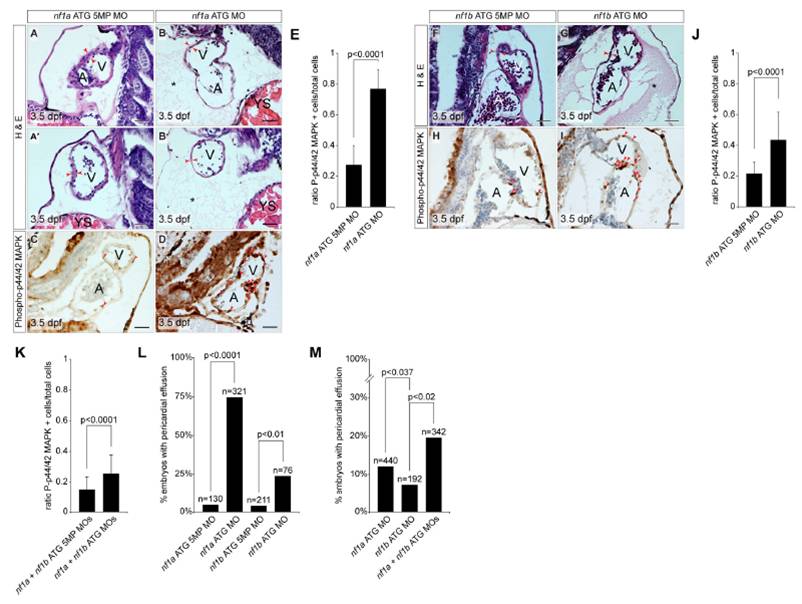Fig. S6 MO knockdown of nf1a or nf1b results in a thinning of the ventricular myocardium and increased phospho-Erk staining in cardiac tissue. (A, A′, B, B′, F, and G) Transverse histological sections through the heart of 3.5-dpf zebrafish embryos reveals a thinning of the ventricular myocardium (red arrows) of zebrafish treated with nf1a or nf1b ATG MOs when compared with the corresponding controls (A, atrium; V, ventricle; YS, yolk sac). Notably, a large pericardial effusion can be appreciated in nf1a and nf1b morphants (*). (C,D,H, and I) Immunohistochemichal analysis of transverse sections through 3.5-dpf zebrafish hearts reveals an up-regulation of phospho-p44/42 MAPK (phospho-Erk) in nf1a or nf1b morphants when compared with the appropriate 5MP controls. The ratio of phospho-Erk-positive cardiac cells to the total number of cardiac cells was quantified over multiple sections for nf1a MO(2 ng), nf1bMO(2 ng), and nf1a+nf1b MO (2 ng) groups (mean ratio phospho-p44/42 MAPK positive cardiac cells/total cardiac cells ± SD) (E, J, and K). (L) Quantification of percentage of embryos displaying a pericardial effusion phenotype at 3.5 dpf following injection of ≈2 ng of nf1a ATG 5MP MO, nf1a ATG MO, nf1b ATG 5MP MO, or nf1b ATG MO. Some 75% of nf1a ATG morphants displayed pericardial effusions as compared with5%of nf1a ATG 5-mispair (5MP) morphant controls (P<0.0001). Some 24% of nf1b ATG morphants displayed pericardial effusions as compared with 4% of nf1b ATG 5MP morphant controls (P < 0.01). (M) Quantification of percentage of embryos displaying a pericardial effusion phenotype at 3.5 dpf following injection of nf1a ATG MO, nf1b ATG MO, or nf1a + nf1b ATG MO. A suboptimal dose (1 ng) of nf1a ATG MO resulted in a 12% incidence of pericardial effusion, whereas a suboptimal dose (1 ng) of nf1b ATG MO resulted in a 7% incidence of pericardial effusion. Injection of 1 ng of a combination of nf1a + nf1b ATG MO, however, resulted in a 20% incidence of pericardial effusion. (Scale bars: 25 μm.)
Image
Figure Caption
Acknowledgments
This image is the copyrighted work of the attributed author or publisher, and
ZFIN has permission only to display this image to its users.
Additional permissions should be obtained from the applicable author or publisher of the image.
Full text @ Proc. Natl. Acad. Sci. USA

